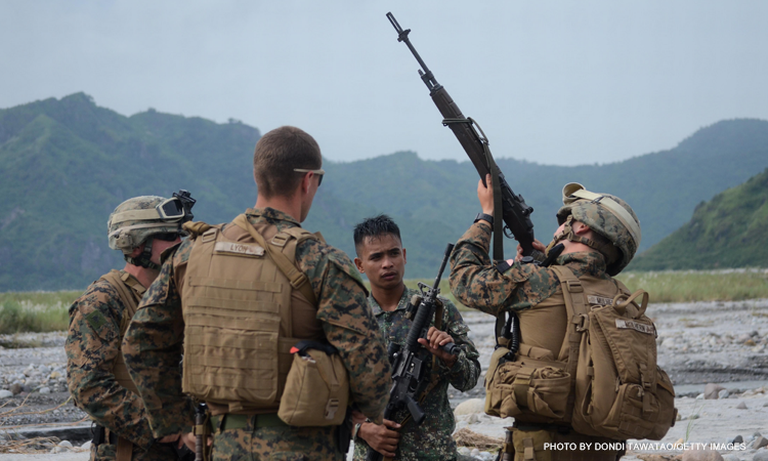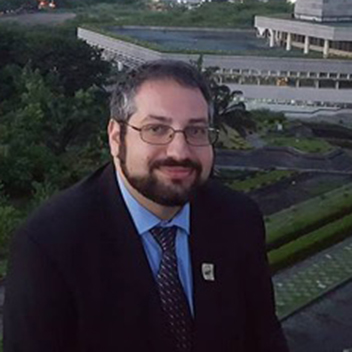
Photo Source: CNN Philippines
Aristotle advised that if we are to understand anything we must “observe its beginning and its development.” Unfortunately, amid the tumult surrounding Secretary Lorenzana’s pledge to review the Mutual Defense Treaty (MDT), an appreciation for the historic origins and development of the U.S.-Philippine alliance has been sadly absent. Although clarifying the rights and obligations contained within the MDT represents a worthwhile undertaking, attempting to do so while ignoring the treaty’s historic context and evolution would be futile. To that end, it is useful to look at the specific charges currently levelled against the MDT by its critics and to identify the historical background of these contentions. This perspective provides both a deeper understanding of U.S. policy towards the Philippines and also helps contextualize the current dispute.
1: The MDT is one-sided and fails to protect Philippine interests in the South China Sea.
This controversy is central to the current dispute and has been a contentious issue within the alliance dating back to the 1970s. The heart of the disagreement is Article V of the MDT, which states that the treaty applies only to “the metropolitan territory of either of the Parties, or on the island territories under its jurisdiction in the Pacific or on its armed forces, public vessels or aircraft in the Pacific.” Since the “metropolitan territory” of the Philippines is defined strictly as the territory transferred to the United States by Spain in 1898 and subsequently to the Philippines in 1946, the South China Sea in general and the Spratly Islands in particular are not under the purview of the MDT.
It is first worth noting that the language used in Article V and the emphasis on “metropolitan territory” was not unique to the MDT nor meant to disadvantage the Philippines. Rather, it constituted the diplomatic norm of the time for U.S. alliances. Most notably, Article V of the 1951 Australia, New Zealand, United States (ANZUS) Treaty, which was negotiated at the same time as the MDT, contains identical language on geographic limits including the emphasis on “metropolitan territory.” This formulation reflected the security concerns of the early 1950s, particularly the fear of a large-scale military invasion of an ally’s home territories. This prospect may seem remote today, but a decade after imperial Japanese forces swept across the Pacific and mere months after the onset of the Korean War, the threat of another Pacific War seemed very real when the MDT was negotiated. Consequently, the emphasis on “metropolitan territory” was not an attempt to shirk responsibility, but a guarantee that even though the Philippines was now an independent state, a repeat of the 1941 invasion would still be forcibly opposed by the United States.
The question of whether the MDT applied to the South China Sea did not emerge until the 1970s. In the late 1960s, significant oil reserves were discovered in the seabed, triggering a mad scramble by claimant states to seize control of disputed maritime features. This led to numerous violent incidents like the Battle of Paracel Islands in 1974 when China forcibly expelled South Vietnamese forces and consolidated its control over the island chain. Fearing that a similar attack might occur against Philippine possessions in the Spratly group, in 1975 Ferdinand Marcos explicitly asked the United States whether the MDT included Philippine claims in the South China Sea.1 The U.S. State Department concluded that since the United States takes no stance on the question of sovereignty over the South China Sea, territories within the Spratly group were not covered by the MDT since they were not part of the metropolitan territories.2
A year later, the question of the MDT being applied to the South China Sea was discussed in greater detail by Secretary of State Henry Kissinger and Secretary of Foreign Affairs Carlos Romulo in October 1976. During a meeting in New York concerning the renegotiation of the bases agreement, Kissinger informed Romulo that if the Philippines wanted territories like Reed Bank and the Spratly Islands included in the MDT, then the U.S. would need to insert some waffling language to allow for flexibility. Such changes could extend the geographic scope of the MDT, but they would also weaken the American obligations under the treaty. In response, Romulo confirmed that Manila did not want to involve the U.S. in the Spratly Islands. He also clarified that “we want to exclude controversial areas. We want the treaty to cover the defense of the metropolitan area of the Philippines.” Romulo later added of the non-metropolitan areas including the Spratlys, “we’ll settle those problems ourselves.”3
2: The United States does not extend the same protection to the Philippines that it does to its other treaty allies.
This charge principally concerns the U.S.-Japan alliance and Washington’s position on the dispute between Japan and China over the Senkaku Islands. Like the South China Sea, the United States takes no stance on which country has sovereignty over the Senkaku Islands. However, unlike the South China Sea, the United States has affirmed that the Senkaku Islands are covered by the 1960 Treaty of Mutual Cooperation and Security (TMCS) between the United States and Japan.
At first blush, this seems like an appalling double standard given American unwillingness to extend similar guarantees to the Philippines. Yet again, the issue is not American duplicity, but diplomacy. The TMCS does not contain language similar to Article V of the MDT or ANZUS Treaty concerning metropolitan territories. Instead, Article V of the TMCS defines the geographic scope of the treaty to “the territories under the administration of Japan.” This is significant because while the TMCS and MDT are both American defense treaties, they are not the same. While the U.S. does not recognize Japanese sovereignty over the Senkaku islands, Washington does recognize them as being administered by Japan. This is because the United States assumed responsibility over the islands following World War II under the Treaty of San Francisco as part of its administration of the Ryukyu Islands. This administrative responsibility was later transferred back to Japan in 1972 when Washington formally ended its occupation of Okinawa and the Ryukyu Islands. Since the TMCS concerns only administrative responsibilities and not sovereignty, the Senkaku Islands have to be covered by the treaty.
Least anyone get too excited about amending the MDT to reflect the standard of the TMCS, there are major trade-offs in this approach. Specifically, since the TMCS only addresses administration and not sovereignty, the United States has no obligation to aid Japan in its dispute with Russia over the Kuril Islands. Occupied by the Soviet Union at the end of World War II, the United States continues to recognize some of Kuril Islands as sovereign Japanese territory. Yet since the islands continue to be occupied by Russia, they are not administered by Japan and are therefore not covered by the TMCS. Applying the same formula to the South China Sea would extend the MDT to cover Thitu Island and Second Thomas Shoal, but at the expense of territories already occupied by China including Mischief Reef and Scarborough Shoal. That would be a strikingly poor exchange for the Philippines and undermine regional stability.
3: The MDT does not offer any real protection for the Philippines in the South China Sea.
This is factually untrue. Since the 1970s, it has been the position of U.S. government that while the MDT does not cover territories in the South China Sea, however, Philippine “armed forces, public vessels or aircraft” in the sea are part of the Pacific area and are therefore protected by the MDT. This stance has remained the consistent U.S. policy for over 40 years and been embraced by successive American administrations. First formulated in 1975, it was the basis for the Kissinger-Romulo meeting and reaffirmed by Secretary of State Cyrus Vance in an exchange of diplomatic notes in 1979. Most recently in 1998, Secretary of Defense William Cohen confirmed that the United States considers the South China Sea to be part of the Pacific area and as such, the clause in the MDT about Philippine armed forces and aircraft continues to apply there.
It is easy to lose sight of the value of that assurance amidst China’s seizure of disputed islands and harassment of Philippine fishermen. Yet, for an illustration of how important this facet of the MDT remains, one only needs to look at the history of Chinese conduct towards Vietnam. Unlike with the Philippines, China has repeatedly shown a willingness to use lethal force against Vietnam to further its territorial claims in the South China Sea. For example, in 1988 the Chinese navy killed 64 mostly unarmed Vietnamese soldiers attempting to prevent the annexation of Johnson South Reef. Chinese forces filmed the episode and the video of skirmish is still available on Youtube.
What has prevented the defenders of the BRP Sierra Madre from suffering a similar fate is not their rusted guns or personal bravery, but China’s recognition that any attempt to forcibly dislodge the vessel would violate the MDT. This contrast in Chinese conduct is both telling and significant. Specifically, while some in the Philippines may question the utility of the MDT, China clearly does not. Rather, it is apparent that Beijing is acutely aware of the assurances contained within the MDT and continues to take American security guarantees seriously.
Back to the Future
As the MDT approaches its 7th decade, reviewing its statutes is an important step to maintaining the health of the U.S.-Philippine alliance. Specific clarifications, such as affirming that cyberwarfare and the use of paramilitary forces are types of armed attack covered by Article IV, represent essential updates to existing interpretations of the MDT that are both warranted and needed to meet modern security challenges. Yet, the way forward is not by ignoring the alliance’s past. Established U.S. policies, like those concerning the South China Sea, are based on longstanding norms and understandings that have helped sustain the alliance amid dramatic shifts in the Indo-Pacific. By losing sight of this history amid current frustrations, critics of the MDT risk doing lasting harm to the alliance that will only serve to undermine Philippine security. Nobody but Beijing would benefit from such an outcome.
1Telegram from Ambassador Sullivan (Manila) to State Department, No. 5250, “GOP Concern over NVN Incursion into Spratly Area,” 24 April 1975: Record Group 59: Central Foreign Policy Files (CFPF), National Archives and Records Administration (NARA), College Park MD; Telegram from Sullivan (Manila) to State, No. 5355, “GOP Concern over NVN Incursion into Spratly Area,” 25 April 1975: Record Group 59: CFPF, NARA; President's Daily Brief: 25 April 1975. Accessed via CIA Electronic Reading Room (ERR).
2Telegram from Kissinger (State) to CINPACFLT, No. 116037, “Disputed Territories in South China Sea,” 5 May 1975; CFPF, NARA; Telegram from Kissinger (State) to Manila, No. 133765, “US MDT Commitment and Spratlys,” 9 June 1975: CFPF, NARA.
3Memorandum of Conversation between Kissinger and Romulo, 6 October 1976, Accessed via Digital National Security Archives, George Washington University; Telegram from Kissinger (State) to Manila, No. 250861, “Secretary’s Meeting with Philippine Foreign Secretary,” 8 October 1976. Foreign Relations of the United State 1969–1976, Volume E-12, Documents on East and Southeast Asia., 1973–1976.

Dr. Gregory H. Winger is an Assistant Professor of political science at the University of Cincinnati. He is a Fellow with the National Asia Research Program and former Fulbright Scholar to the Philippines.
